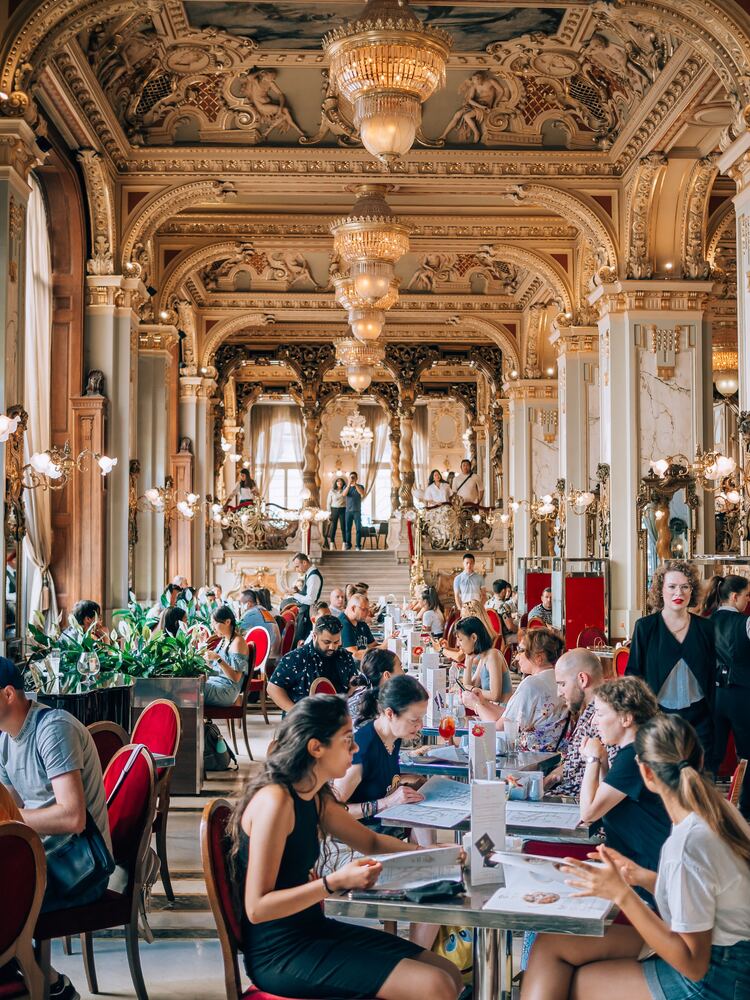This article aims to provide a succinct introduction to the history of coffee.
I have to admit I started drinking coffee in my late 20s. Since my mother is not a coffee drinker, this beverage was never around while I was growing up. I learned to appreciate coffee once I got married.
As a history lover, I am a bit obsessed with food history (probably the most fun historical topic). Coffee is not the exception.
And, well, you cannot have a coffee website without digging into the history of coffee. Right?
So, let’s dive into the rich history of coffee. I hope it captivates your imagination as you learn about this cherished elixir.

History of Coffee: Origins
Ethiopia and Kaldi the Goat Herder
The story of coffee begins in Ethiopia, where the Coffea arabica plant grows wild. It’s believed that Kaldi, a goat herder, discovered the energizing effects of coffee beans around the 9th century. As legend goes, Kaldi noticed his goats becoming more active after consuming red berries from a certain tree. Intrigued, Kaldi tasted the berries himself and experienced the same energy-boosting effects. Eventually, he shared his findings with local monks.
Spread to Yemen and Sufi Monks
As word of the caffeine-rich fruit spread, coffee made its way from Ethiopia to Yemen, where the art of cultivating and brewing coffee was developed. By the 15th century, coffee had become popular in the Sufi monastic communities.
The monks began using coffee to prepare a drink called qahwa. The beverage helped them concentrate and offered a means to stay alert during their spiritual practices.
From there, coffee spread across the Arabian Peninsula and beyond, becoming integral to art, history, and culture.
Spread of Coffee Across the Middle East
The Arabs were the first to recognize the potential of these remarkable berries. They began cultivating coffee plants in the 14th century (in Yemen), to keep this precious commodity a well-guarded secret.
Coffee’s popularity increased in the Arabian Peninsula, not only for its energizing effects but also for its rich, aromatic flavors. Arab traders introduced coffee to various parts of the world, spreading its allure to neighboring regions and beyond.
As Islam spread, so did the love for coffee. Islamic religious authorities initially debated whether coffee should be considered an intoxicant, similar to alcohol. However, it was ultimately deemed permissible, and its consumption became integral to Islamic culture.
The establishment of coffeehouses, known as “qahveh khanehs,” became a vital social aspect of Islamic society. These coffeehouses served as gathering places where people would engage in intellectual discussions, engage in business transactions, and enjoy the stimulating effects of the beverage.
As trade routes expanded, coffee reached various parts of the Islamic world, including Egypt, Persia, Syria, and Turkey. Each region added its unique twist to the preparation and serving of coffee, contributing to the diverse coffee traditions that still exist today.

History of Coffee: Expansion to Europe
The First Mentions of Coffee in European Travel Accounts
The allure of coffee reached the European continent through captivating travel accounts of explorers and merchants. In the early 17th century, travelers who ventured to the Middle East and the Ottoman Empire began documenting their encounters with this stand-out beverage.
One of the first notable mentions of coffee in European travel accounts dates back to 1573 when Leonhard Rauwolf, a German physician, visited the city of Aleppo in present-day Syria. Rauwolf described the vibrant coffee culture he witnessed, marveling at the unique brewing method and the stimulating effects of the beverage.
These intriguing travel accounts sparked curiosity and interest among European intellectuals, eagerly awaiting the opportunity to experience this novel beverage.
The Establishment of the First Coffeehouses in Constantinople and Venice
The establishment of the first coffeehouses played a significant role in introducing coffee to European society.
In Constantinople (now Istanbul), the first coffeehouse, the Kiva Han, was established in the mid-16th century. It quickly became a gathering place for people from all walks of life, fostering discussions on politics, literature, and the arts. The popularity of the Kiva Han spread rapidly, opening numerous coffeehouses throughout the city.
Venice, a vibrant center of trade and commerce, witnessed the arrival of coffee in the early 17th century. The first coffeehouse in Venice, the Bottega del Caffè, opened in 1645. Venetians embraced the new beverage and its social culture, making coffeehouses an integral part of the city’s social fabric.
Coffee’s Introduction to Other European Countries
Coffee eventually found its way to other European countries. The early 17th century marked the arrival of coffee in England, thanks to the efforts of a Turkish merchant named Pasqua Rosée. He introduced the concept of coffeehouses to London, establishing the first one in 1652. Coffeehouses quickly became a hub for intellectual debates and discussions.
France, known for its cultural refinement, embraced coffee in the late 17th century. Coffeehouses, known as “cafés,” began to sprout across Paris, catering to the burgeoning intellectual and artistic communities. French coffee culture heavily influenced the development of coffee brewing techniques and the art of coffee preparation.
The Netherlands, renowned for its seafaring and trade networks, was pivotal in introducing coffee to Europe. The Dutch East India Company played a significant part in coffee’s global expansion, bringing coffee beans from their colonies and establishing coffee plantations in their overseas territories.

The Rise of the Coffee Culture
The Emergence of Coffeehouses as Social Hubs
In the 17th and 18th centuries, coffeehouses emerged as vibrant social spaces that fostered intellectual discussions, debates, and exchanging ideas. These establishments became the birthplace of coffeehouse culture, attracting scholars, writers, philosophers, and artists.
Coffeehouses provided an egalitarian environment where people from different social backgrounds could engage in lively conversations. The atmosphere of intellectual curiosity and open dialogue made coffeehouses a breeding ground for exchanging knowledge and ideas.
The Role of Coffeehouses in Shaping Societal, Political, and Cultural Movements
Coffeehouses played a crucial role in shaping societal, political, and cultural movements of the time. They became hotspots for political activism, where discussions on social reforms and revolutionary ideas took place. In coffeehouses, individuals challenged traditional norms and contributed to forming new ideologies.
These establishments also acted as information hubs, circulating news, pamphlets, and publications. Coffeehouses became centers of political and literary publications, enabling the dissemination of ideas and the formation of public opinion.
Notable Coffeehouses and Their Impact on Literature, Arts, and Science
Several notable coffeehouses emerged, becoming iconic symbols of intellectual and cultural movements.
- The Café Procope in Paris, established in 1686, became a hub for Enlightenment thinkers and philosophers. It hosted influential figures such as Voltaire, Rousseau, and Diderot, who engaged in spirited discussions that fueled the Enlightenment movement.
- The Lloyd’s Coffee House in London, founded in 1688, was pivotal in developing the insurance industry. Merchants and shipowners gathered there to negotiate marine insurance policies, laying the foundation for the renowned Lloyd’s of London.
- The Café Florian in Venice, established in 1720, became a meeting place for artists, writers, and musicians during the height of the Venetian Republic. It inspired renowned composers such as Mozart and attracted famous literary figures like Lord Byron.
- The Café de Foy in Paris, frequented by artists and writers in the 19th century, witnessed the birth of artistic movements such as Romanticism. Artists like Eugène Delacroix and writers like Victor Hugo found inspiration within its walls.

History of Coffee: The Age of Plantations
The Dutch and French Colonization of Coffee-Growing Regions
During the Age of Exploration, European powers sought to control valuable trade routes and establish colonies in resource-rich regions.
The Dutch East India Company, known for its dominance in the spice trade, began cultivating coffee in its colonies. In the 17th century, the Dutch established coffee plantations in their colonies in present-day Indonesia, particularly in the islands of Java and Sumatra. These plantations became significant producers of coffee, supplying Europe with high-quality beans.
Similarly, the French expanded their colonial influence in the Caribbean, particularly Haiti, Martinique, and Guadeloupe. These regions offered ideal conditions for coffee cultivation, including fertile soils and a favorable climate. The French established large-scale coffee plantations, exporting vast quantities of coffee to Europe.
The Expansion of Coffee Plantations in the Americas
Expanding coffee plantations in the Americas, particularly in Brazil and the Caribbean, played a pivotal role in shaping the global coffee industry.
Brazil emerged as a dominant force in coffee production during the 19th century. The favorable climate and vast land in Brazil’s regions, such as São Paulo and Minas Gerais, allowed extensive coffee cultivation. Brazilian coffee rapidly gained popularity due to its rich flavor and high-quality beans, eventually becoming the largest coffee producer in the world.
In the Caribbean, countries such as Jamaica, Cuba, and Puerto Rico also witnessed the establishment of coffee plantations. These regions’ unique combination of tropical climates and volcanic soils produced sought-after Arabica coffee beans. Jamaican Blue Mountain coffee, mainly, gained a reputation for its exceptional quality and distinct flavor profile.
The Rise of Slave Labor
The rise of coffee plantations brought forth a dark side in the form of slave labor. As the demand for coffee increased, so did the need for a large workforce to cultivate and harvest the coffee crops.
Slave labor was prevalent in coffee-growing regions, including the Dutch colonies in Indonesia and the French colonies in the Caribbean. However, the most notorious example was in the Americas, particularly Brazil. Millions of enslaved Africans were forcibly brought to Brazil and other parts of the Americas to work on coffee plantations under harsh and inhumane conditions.
The use of slave labor in coffee production profoundly impacted the lives of millions, leading to immense suffering, loss of freedom, and the perpetuation of racial injustices. The legacy of slavery in the coffee industry continues to be a painful reminder of its dark past.

The History of Coffee: The Industrial Revolution
The Birth of the Coffee Industry
The Industrial Revolution, a period of rapid industrialization and technological advancements, profoundly impacted the coffee industry. During this time, innovative coffee-making technologies were developed, revolutionizing how coffee was prepared and consumed.
One significant invention was the coffee percolator, patented by American farmer Hanson Goodrich in 1889. This device allowed for the brewing of coffee by continuously cycling hot water through the coffee grounds, resulting in a more efficient and convenient brewing process.
Additionally, the invention of the commercial coffee roaster and grinder machines further transformed the coffee industry. These machines allowed for large-scale production, ensuring consistent roasting and grinding processes and enabling the packaging and distribution of coffee on a mass scale.
The Rise of Coffee Consumption
The Industrial Revolution changed working conditions and lifestyles, and coffee played a significant role. Coffee became a staple beverage for the working class, offering an energizing effect, particularly valued in factory and labor-intensive environments.
The availability and affordability of coffee increased due to advancements in transportation and trade. This led to a significant rise in coffee consumption among the working class, providing a much-needed energy source and respite during long working hours.
Once exclusive to the elites, coffeehouses became accessible to a broader range of people during this period. They served as social gathering places where individuals could relax, exchange ideas, and discuss current events over a cup of coffee.
Coffeehouses became integral to working-class culture, fostering community and providing a sense of belonging.
The Proliferation of Coffee Brands
With the growth of industrialization and urbanization, the demand for coffee skyrocketed, leading to the proliferation of coffee brands and the development of new roasting and grinding techniques.
Coffee brands began to emerge, each offering its unique blend and flavor profile. Companies focused on marketing their coffee as a product of quality and consistency, catering to consumers’ evolving preferences.
Roasting techniques also evolved during this time. The invention of industrial roasters allowed for more precise control over the roasting process, resulting in consistent and customizable flavor profiles. Similarly, grinding techniques were refined, ensuring the desired grind size for different brewing methods, such as espresso or drip coffee.
The combination of technological advancements, the rise of coffee consumption among the working class, and the development of diverse coffee brands contributed to transforming the coffee industry into a global, mass-produced commodity.

The History of Coffee: Modern Era
The Rise of Instant Coffee
The modern era witnessed the rise of instant coffee, which significantly impacted coffee culture. Instant coffee, first commercially produced in the late 19th century, gained popularity for its convenience and ease of preparation. This powdered coffee offered a quick and accessible solution for those seeking a fast caffeine fix.
Instant coffee became especially prevalent during times of war and in areas with limited access to fresh coffee beans. Its popularity soared as advancements in technology and production methods improved the taste and quality of instant coffee.
While instant coffee provided convenience, it also impacted the perception of coffee. The focus shifted from the craftsmanship of coffee brewing to instant gratification. However, it paved the way for a wider acceptance and appreciation of coffee as a beverage, leading to the continued growth and diversification of the coffee industry.
The Specialty Coffee Movement
The specialty coffee movement emerged in response to the dominance of instant coffee and a desire for higher-quality brews. This movement placed a renewed emphasis on coffee’s quality, origin, flavor profile, and sustainable and ethical practices.
Specialty coffee focuses on sourcing and roasting high-quality beans, often from specific regions or single-origin farms. The movement highlights different coffee varieties’ unique characteristics and complexities, encouraging consumers to appreciate their cups’ nuanced flavors and aromas.
Additionally, the specialty coffee movement promotes sustainable practices throughout the supply chain. It emphasizes fair trade, direct trade, and relationships with coffee farmers, ensuring they receive fair compensation for their work. This movement also prioritizes environmentally friendly practices, such as shade-grown coffee and responsible waste management.
The Globalization of Coffee Chains
The modern era witnessed the globalization of coffee chains and the proliferation of coffee shop culture worldwide. International coffee chains, such as Starbucks, Costa Coffee, and Dunkin’, expanded their reach and introduced standardized coffee experiences across different countries and cultures.
Coffee shops became more than places to grab a cup of coffee; they became social hubs and a part of people’s daily routines. The coffee shop culture encouraged the creation of welcoming spaces for individuals to work, meet friends, or enjoy their favorite brew. It fostered a sense of community and connection among coffee lovers.
Moreover, coffee shop culture brought the popularity of various brewing methods and specialty beverages. From espresso-based drinks like cappuccinos and lattes to pour-over and cold brew techniques, coffee shops offer various options to cater to different preferences.

History of Coffee: Evolution of Preparation
Brewing Technology
Over time, the methods of brewing coffee have evolved to extract the best possible flavors. In the early days, you may have boiled the grounds in water. Next, the steeping method emerged, where you would let your coffee grounds soak in water and then strain the liquid. Later came drip coffee, with machines perfecting the brewing process by controlling water temperature and coffee-to-water ratios. This helped bring out the deliciousness of your morning brew.
Espresso and Italian Coffee Culture
Espresso became the heart of Italian coffee culture since its invention in the early 20th century. It started with developing the first espresso machine in 1901 by Italian inventor Luigi Bezzera, which allowed for quicker brewing under high pressure. This innovative process retained the coffee’s flavors and produced a thicker, richer crema atop your cup of espresso. Over the years, the espresso machine improved and evolved, giving you the modern marvels commonly seen in today’s cafes.
Specialty Coffee Movement
The specialty coffee movement emerged in the 1960s and 1970s, focusing on origin, quality, and unique flavor profiles. New brewing techniques, such as the French press, Chemex, and pour-over, began appearing to provide you with a better-tasting cup of coffee. You started to see more single-origin and small-batch roasts highlighting specific regions and stories behind the beans. This movement has allowed you to experience different flavors from around the world.
Innovation in Coffee Roasting
The art of coffee roasting has come a long way. The process has evolved with new technology from simple pan-roasting, giving better control and precision over the roast. Modern roasting equipment, such as air and drum roasters, allow for consistent heat application, bringing out the best flavors in your coffee. With programmable roasting profiles and meticulous temperature monitoring, roasters can now create unique, precise roasts tailored to showcase specific attributes of the beans.

The Coffee Industry
Major Coffee-Producing Countries
When it comes to coffee production, some countries stand out. Brazil has been the largest coffee producer in the world for over 150 years. Other significant players in the coffee industry include Colombia, Vietnam, and Indonesia. These countries have diverse climates and growing conditions, which contribute to the unique flavor profiles of their beans.
Economic Impact of Coffee Production
Coffee is not only a beloved beverage; it’s also a major global commodity. It’s the second most traded commodity after oil. The economic impact of coffee production is enormous, affecting millions worldwide. It provides employment opportunities in the growing, processing, marketing, and retail sectors.
Countries with significant coffee production, like Brazil, benefit from this industry in terms of foreign exchange and GDP. In some countries, the industry faces challenges such as a lack of quality control, unstable prices, and depletion of natural resources. However, organizations like the Specialty Coffee Association and Fair Trade are working to improve the sustainability and quality of the coffee trade.
Prominent Coffee Companies
There are many prominent coffee companies worldwide, but one that stands out is Starbucks. Founded in 1971, Starbucks brought specialty coffee to the mainstream, emphasizing high-quality beans, unique roasting techniques, and customized drinks.
Maxwell House, another well-known coffee producer, was established in the USA in 1892 and gained popularity during World War II.
Both chains have played an essential role in shaping the modern coffee industry.
Other notable companies in the industry include:
- Dunkin’ Donuts
- Nescafé
- Peet’s Coffee
- Tim Hortons
These companies have unique styles, blends, and preparations catering to consumer preferences.
Environmental and Social Concerns
The coffee industry faces some environmental and social concerns. Large-scale coffee cultivation contributes to deforestation and biodiversity loss. In some areas, traditional coffee-growing techniques give way to monoculture farming and chemical fertilizers, which can harm the ecosystem.
Additionally, the coffee industry deals with social issues such as child labor, unfair labor practices, and low wages for farmers. Efforts to address these issues include promoting sustainable agriculture practices like shade-grown coffee, agroforestry, and organic farming. Ethical labels such as Fair Trade and Rainforest Alliance certifications encourage better environmental practices and improved living conditions for workers.
Despite the challenges, the coffee industry’s growth will continue to shape the global economy, culture, and environment. And as a coffee lover, you can make a difference by supporting sustainable and ethical practices.

Frequently Asked Questions
Where did coffee originate from?
Coffee is believed to have originated in the ancient forests of Ethiopia. According to legend, a goat herder named Kaldi observed his goats becoming more energetic after eating the berries of a particular plant. Curious, he tried some himself and felt an invigorating effect. From there, the use of coffee spread throughout the region.
What was coffee initially used for?
Coffee was initially consumed for its stimulating properties. In the early days, coffee berries were ground and mixed with animal fat to create energy-rich balls suitable for sustenance during long journeys. Moreover, coffee was appreciated for its medicinal benefits, and over time, its social relevance increased as coffee houses began to emerge in the Middle East.
When was coffee introduced to Europe?
Travelers and traders from Africa and the Middle East introduced coffee to Europe in the 17th century. The first trading shipments of coffee arrived in Venice in 1615, and the first coffee house opened in Italy in the mid-17th century. Coffee houses then opened in England, where they became trendy, and by the 18th century, they had spread throughout Europe.
How did coffee become popular?
Coffee’s popularity can be attributed to its numerous advantages. Its stimulating properties made it a popular drink among those seeking energy and focus. In addition, coffee houses provide a welcoming atmosphere for socializing, conducting business, and sharing ideas. These factors and the spread of transportation networks ensured that coffee became a significant global commodity.
Where is coffee mainly grown?
Coffee is primarily cultivated in countries along the equator within the so-called Coffee Belt. The Coffee Belt consists of Latin America, Africa, and Asia regions. Brazil, Vietnam, and Colombia are among the largest coffee-producing countries in the world. These regions provide the ideal climate and conditions required for the growth of coffee plants.
How was coffee originally made?
Initially, coffee was prepared quite differently compared to modern methods. The coffee fruit, known as the “cherry,” was mashed and mixed with water. This method created a thick and pulpy beverage, resembling fruit juice more than traditional coffee. As the popularity of coffee grew, different brewing methods evolved, including boiling the grounds, steeping them in water, and eventually, using pressure and heat to create an extraction – the way we enjoy coffee today.

Well, this ended up being quite the article! I immensely enjoyed taking you through the history of coffee. I know many books have been written about this topic. Therefore, I have tried to condense centuries into less than 4,000 words. I hope you learned something new!
Tell me, what other history of coffee topics are you interested in?